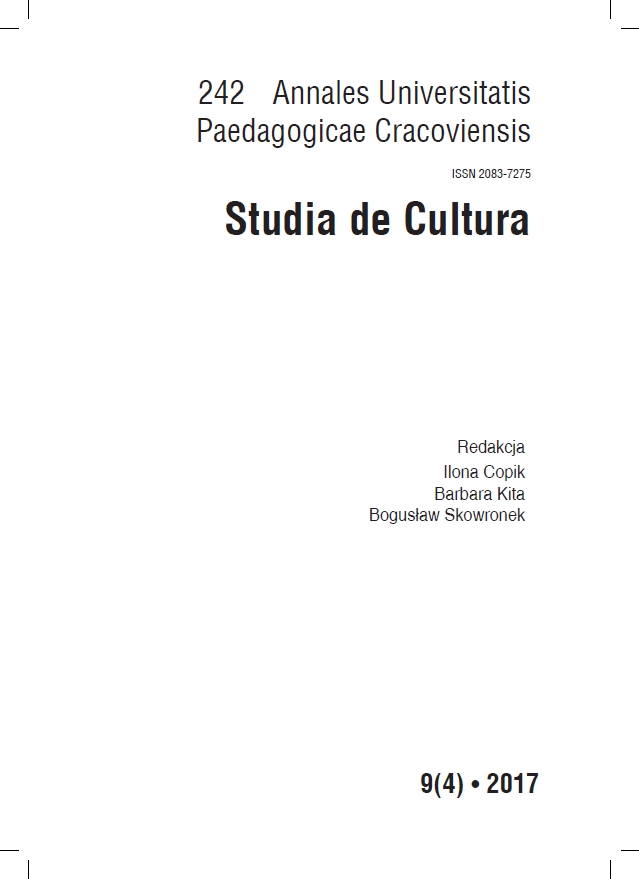Abstract
DOI 10.24917/20837275.9.4.4
Celem artykułu jest ukazanie problematyki wizualizacji danych w kontekście komunikacyjnym. Infografika staje się dziś za sprawą dziennikarstwa danych i popularności mediów wizualnych narzędziem powszechnie stosowanym; nie do końca rozpoznane są jednak właściwości manipulacyjne projektowania graficznego, które przedstawiane jest odbiorcom jako ilustrujące, tłumaczące i wyjaśniające treści statystyczne oraz tekstowe w sposób systemowy, uporządkowany i wizualny, co konotuje prostotę i uniwersalność oraz obiektywizm. Autorka stara się wykazać, jak idealistyczne teorie z zakresu projektowania informacji rzutują na proces nadawczo-odbiorczy (z jednej strony dając przestrzeń na manipulację danymi, z drugiej - tworząc idealny obraz projektanta jako strażnika obiektywizmu i posiadacza kompetencji interpretatora, wyzwalają tym samym bezbronność odbiorców w dekodowaniu języka wizualizacji danych i pozbawiają ich czujności, należnej przekazom perswazyjnym). Tymczasem, przekaz graficzny ma charakter nie tylko edukacyjny, ale też często polityczny czy szerzej - ideologiczny. Analiza przekazów graficznych zamieszczonych w portalu Visualizing Palestine (wybranego ze względu na globalny zasięg i popularność, polaryzację polityczną odbiorców oraz nowatorski, partycypacyjny i społecznościowy charakter procesu projektowego), służy tu przedstawieniu technik wizualizacji jako interpretacji i manipulacji danymi, a także potwierdza moc dyskursywną infografiki jako narzędzi komunikacyjnych. Artykuł ma na celu zwrócenie uwagi na problem powszechnego braku kompetencji w zakresie dekodowania znaczeń zawartych w wizualizacjach danych (datavis) oraz celowej (lub nie) nonszalancji projektantów w kwestii podejścia do danych.
The Dataspace: Between Information Design and Data Manipulation. The Analysis of Specificity of Infographic Messages Based on Case Study of Visualising Palestine
The goal of the paper is to present the issues concerning data visualisation in communication context. Infographics nowadays becomes - due to data journalism and popularity of visual media - a commonly used tool; but still little recognition is given towards manipulatory features of graphic design which is presented to its recipients as illustrating, translating and explaining statistical and textual content in systemic, ordered and visual way that connotes simplicity, universality and objectivity. The author tries to prove that idealistic information design theories impact the communication process (on one hand giving the space for data manipulation, on the other - creating an ideal image of a designer seen as a guard of objectivism and an owner of an interpreter’s competences, thus they evoke recipients’ vulnerability in decoding the language of data visualisation and deprive them of awareness, which they should devote to persuasive messages). Whereas graphic message is not only of an educational nature but also often of a political or - widely speaking - an ideological one. The goal of the analysis of infographics published at the Visualizing Palestine website (chosen for its global range and popularity, as well as for the political polarisation of its recipients and for innovative, participative and grassroot character of the design process) is to indicate the technics of visualisation as interpretation and also data manipulation, as well as to prove the discoursive potential of infographics as a communication tool. The paper aims at drawing attention to the common lack of competences in the range of decoding meanings of datavis and the nonchalance (whether conscious or not) of designers in their usage of data.
References
Bergström Bo. 2009. Komunikacja wizualna. J. Tarnowska (przeł.). Warszawa: Wydawnictwo Naukowe PWN.
View in Google Scholar
Bogost Ian, S. Ferrari, B. Schweizer. 2012. Gry informacyjne. Dziennikarstwo epoki cyfrowej.
View in Google Scholar
J. Gilewicz (przeł.). Kraków: Wydawnictwo Uniwersytetu Jagiellońskiego.
View in Google Scholar
B’Tselem, 2004. Forbidden Roads: Israel’s Discriminatory Road Regime in the West Bank. http://www.btselem.org/about_btselem [dostęp: 11.07.2017].
View in Google Scholar
Frid-Jimenez Amber, B. Dalton. 2013. Data is Political: Investigation, Emotion and the Accountability of Institutional Critique. W: Accountability Technologies. Tools for Asking Hard Questions. D. Offenhuber, K. Schechtner (red.). Vienna: Ambra V, 14–22.
View in Google Scholar
Lenk Krzysztof. 2010. Krótkie teksty o sztuce projektowania. Gdańsk: Słowo / obraz terytoria.
View in Google Scholar
Maeda John. 2006. The Laws of Simplicity. Design, Technology, Business, Life. Cambridge, Massachusetts: The MIT Press.
View in Google Scholar
Maj Anna. 2014. „The Role of Retention and Data Analysis in the Ubicomp Paradigm”. Transformations–An Interdisciplinary Journal nr 3–4(82–83), 24–45.
View in Google Scholar
Manovich Lev. 2001. Info-Aesthetics. Information and Form. Bloomsbury Academic. http://manovich.net/index.php/projects/info-aesthetics [dostęp: 11.07.2017].
View in Google Scholar
Manovich Lev. 2008. Introduction to Info-Aesthetics. http://manovich.net/content/04-projects/060-introduction-to-info-aesthetics/57-article-2008.pdf [dostęp: 11.07.2017].
View in Google Scholar
Papanek Victor. 2012. Dizajn dla realnego świata. Środowisko człowieka i zmiana społeczna. J. Holzmann (przeł.). Łódź: Wydawnictwo Recto Verso.
View in Google Scholar
Rams Dieter. 2011. As Little Design as Possible. London: Phaidon Press.
View in Google Scholar
Rams Dieter. 2014. Less, but Better. Berlin: Gestalten.
View in Google Scholar
Ries Eric. 2011. The Lean Startup. How Today’s Entrepreneurs Use Continuous Innovation to Create Radically Successful Businesses. New York: Crown Business, Random House.
View in Google Scholar
SFMOMA. 2011. Less and More. The Design Ethos of Dieter Rams. https://www.sfmoma.org/press/release/sfmoma-presents-less-and-more-the-design-ethos-of/ [dostęp: 11.07. 2017].
View in Google Scholar
Stasieńko Jan. 2011. Perspektywy wykorzystania wizualizacji cyfrowych w badaniu utworów literackich. W Od liberatury do e-literatury. E. Wilk, M. Górska-Olesińska (red.). Opole: Wydawnictwo Uniwersytetu Opolskiego. 65–79.
View in Google Scholar
Tufte Edward R. 1990. Envisioning Information. Cheshire, Connecticut: Graphic Press.
View in Google Scholar
Tufte Edward R. 2001. The Visual Display of Quantitative Information. Cheshire, Connecticut: Graphic Press.
View in Google Scholar
UN OCHA. 2007. The Humanitarian Impact on Palestinians of Israeli Settlements and other Infrastructure in the West Bank. http://www.ochaopt.org/documents/thehumanitarianimpactofisraeliinfrastructurethewestbank_full.pdf, http://www.ochaopt.org/.
View in Google Scholar

